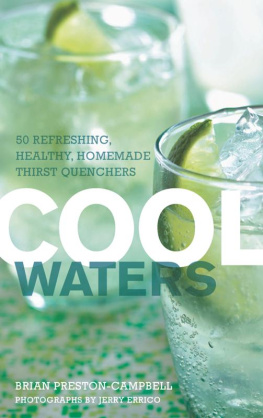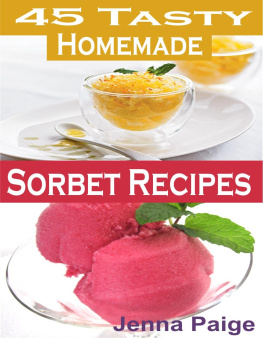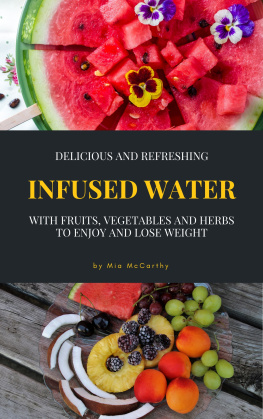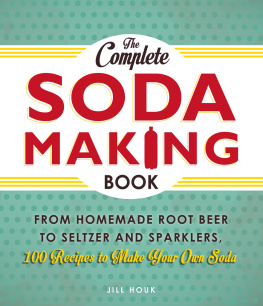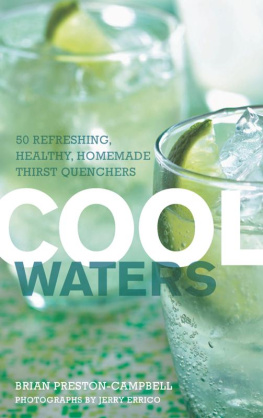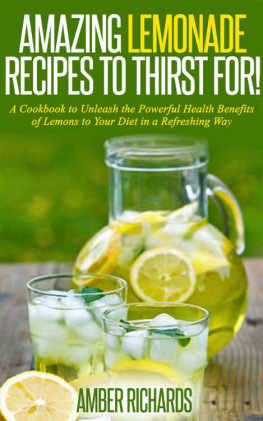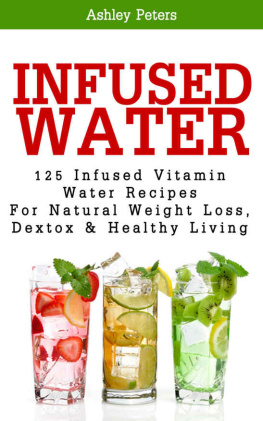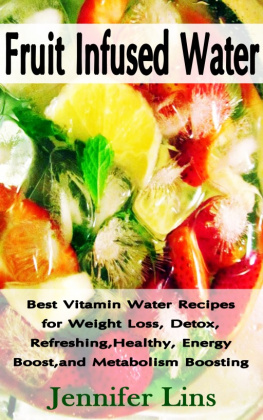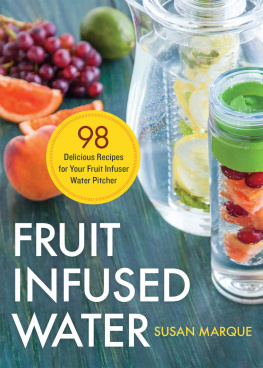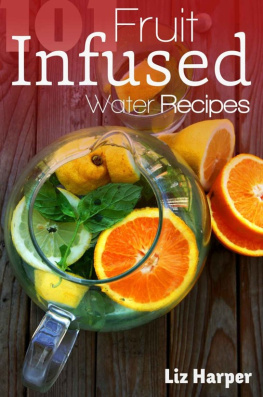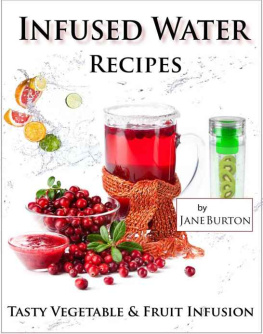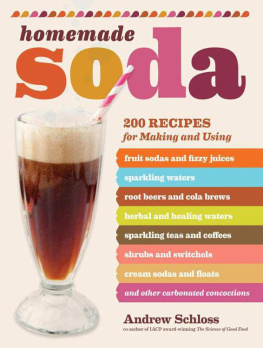For Shade, a velvet, cool drink of water
J.E.
For Rebecca, Ian, and Caleb
B.P-C.
The Harvard Common Press
535 Albany Street
Boston, Massachusetts 02118
www.harvardcommonpress.com
Copyright 2009 by Brian Preston-Campbell
Photographs copyright 2009 by Jerry Errico
All rights reserved. No part of this publication may be reproduced
or transmitted in any form or by any means, electronic or mechanical,
including photocopying, recording, or any information storage
or retrieval system, without permission in writing from the publisher.
Printed in China
Printed on acid-free paper
Library of Congress Cataloging-in-Publication Data
Preston-Campbell, Brian.
Cool waters : 50 refreshing, healthy, homemade thirst quenchers /
Brian Preston-Campbell ; photographs by Jerry Errico.
p. cm.
Includes index.
ISBN 978-1-55832-384-1 (hardcover : alk. paper)
1. Beverages. 2. Drinking water. 3. Fruit drinks. I. Title.
TX815.P74 2009
641.2'6--dc22
2008022600
Special bulk-order discounts are available on this and other Harvard
Common Press books. Companies and organizations may purchase
books for premiums or resale, or may arrange a custom edition, by
contacting the Marketing Director at the address above.
Book design by Vivian Ghazarian
Photographs by Jerry Errico
Food styling by Brian Preston-Campbell
Prop styling by Martha Bernabe
Front jacket recipe: Pineapple and Lime Seltzer,
10 9 8 7 6 5 4 3 2 1
Acknowledgments
Our sincere thanks to Pam Abrams, senior vice president of Downtown Bookworks, whose generosity and professional guidance brought this idea to fruition. A special thanks to Virginia Downes of The Harvard Common Press for her professionalism and enthusiasm, and for the creative freedom she engenders. Also, thank you to Martha Bernabe, stylist, whose talent and energy know no bounds.
Jerry Errico and
Brian Preston-Campbell
Special gratitude goes to my photography agents, Tricia Scott and Brett Sahler, whose friendship I value the most.
Jerry Errico
I extend my deepest appreciation to my editor, Valerie Cimino, and copy editor, Christine Corcoran Cox. An author only writes one first book, and I was fortunate to have two skilled and seasoned professionals to make the final stages of the process seem almost effortless. Additional gratitude goes to dietitian Cindy Sizemore for her nutritional guidance and thorough review of my recipes. And thanks to the Lower East Side Whole Foods Market, for not only stocking most of the ingredients in this book but also providing a quiet refuge in which to write it.
Brian Preston-Campbell

Why Water?
Water is the basis of all life on Earth, and its consumption is, without a doubt, the very foundation of a healthy lifestyle. Many knowledgeable sources, including our doctors and mothers and the mainstream media, constantly advise us to think about hydrationusually telling us to drink at least eight glasses of the clear stuff each day. While that seems like a reasonable proposal for some people, for the rest of us, there just isn't enough going on with water to make it exciting. If we are surrounded by unique food and drink experiences every day, why then does our drinking water have to be so ... plain?
Imagine Cool Waters as a collection of unique cocktail recipes. But these cocktail recipes don't contain any caffeine, added sugar, excessive calories, or even alcohol. Each one is designed to be easy to prepare and, aside from a few simple exceptions, don't require any cooking. What makes the beverages in this book unique is that they are composed mostly of water, yet taste great. Each one is guaranteed to be interesting and go well with food (and other drinks as well). As a bonus, your friends and family won't know what hit them the next time they pick up a drinking glass at your house.
This imbiber's manual starts off with Quick Quenchers, recipes consisting of a few ingredients, with quick and easy steps to get you started. The basic concepts of flavoring water are covered, beginning with recipes that add a few fruit flavors, then gradually becoming more complex combinations.
Interested in an alternative to that sugary sports drink you've been using to "enhance" your workout? The recipes in Nutritious Nectars will get you started in the right direction. This chapter features many exciting ingredients, including trendy dried berries and exotic tropical fruits.
In the chapter that follows, Special Sippers, things get a lot more interesting. We travel the globe for inspiration and discover what can only be described as fusion infusions. Procuring a few of the ingredients may take slightly more effort, but the extra work will be rewarded. I promise you flavor experiences not found in any bottled beverage anywhere!
Prefer your liquids on the rocks? Your chance will come with the unique ice cube recipes found in Cubed Complements. Forget about plain old ice and throw some of these frozen flavors in your glass. They're also a convenient way to spice up plain old flavorless waterkeep a few varieties in the freezer for whenever the mood strikes you.
Just how many possible flavors of water could one make? It seems that the combinations are endlesslimited only by your creativity and access to unique ingredients. Eau de You, at the back of the book, is devoted to the creation of your own signature flavored water. Feel free to experiment with the ingredients listed in whatever combinations appeal to you most. Cheers!
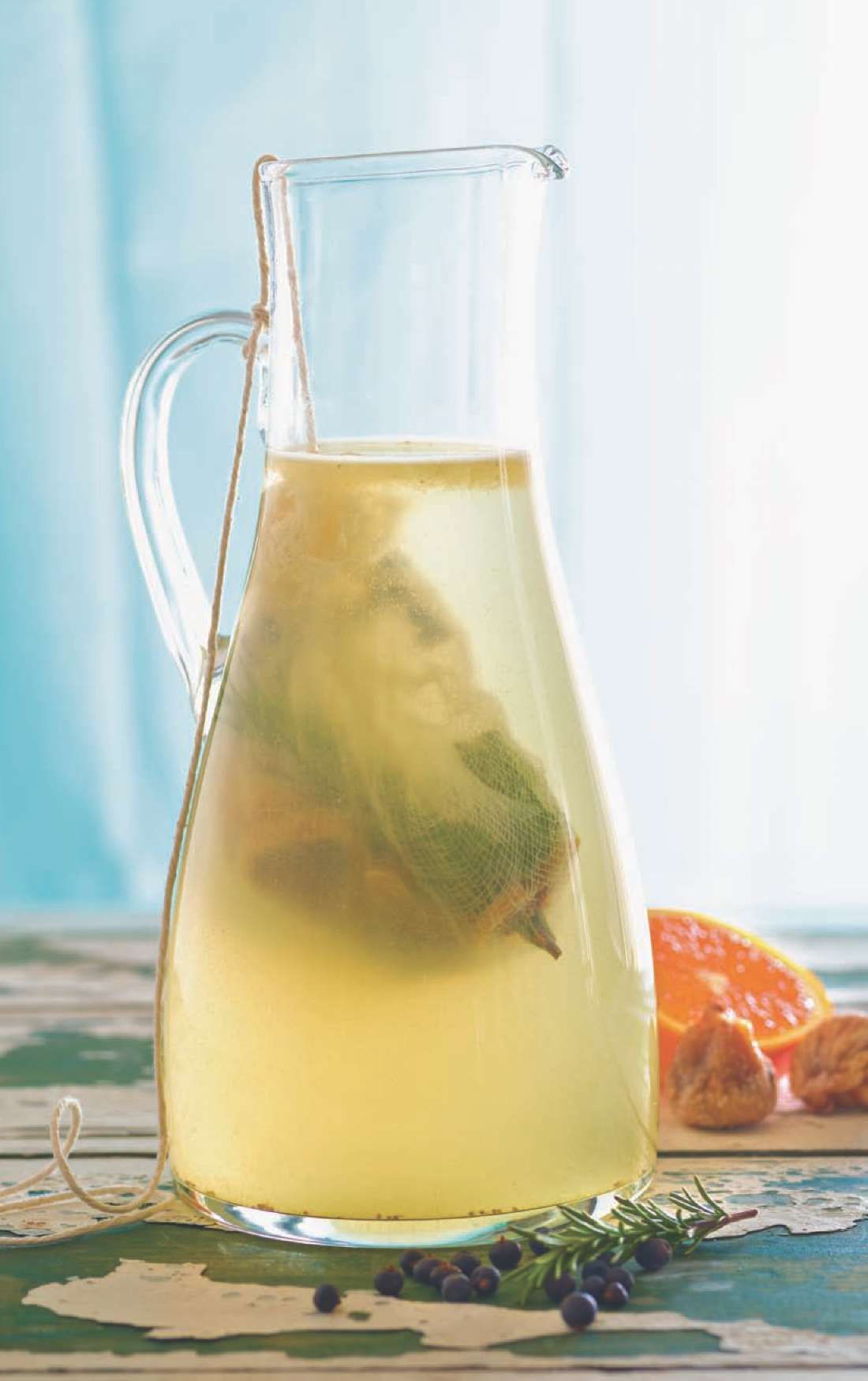
The Basics of Flavored Water
BE STILL
Much of the water needed for the recipes in this book is still, simply meaning it is H2O without bubbles. The water from your faucet is the least expensive, most environmentally responsible choice, and often it is the best source. If you are like me and find your municipal tap water has an acceptable, neutral flavor, then it's ideal for these recipes. Don't have good-tasting tap water? No problemthere are several options to move your water in the right direction. Special pitchers from several companies, including Brita, PR, and Culligan, are a convenient way to keep a couple of liters of filtered drinking water cold in your refrigerator. The filters on these pitchers can be a little slow, however, especially when the pitcher is empty and you're ready to infuse water now.
For instant gratification, PR, Brita, Waterpik, and several other companies make filters that fit right on the end of your kitchen faucet. The threaded couplers screw onto your existing hardware, allowing you to enjoy filtered water with almost no effort and at a faster flow rate than filtered pitchers gallon per minute for faucet filters, compared to cup per minute for pitchers. Faucet filters all have a switch to allow regular tap water to flow when you don't need to use filteredfor washing pots and pans, for example. Many also include an indicator that will inform you when the filter needs to be changedabout every three months or 120 gallons in most cases, but your mileage may vary depending upon how much water you consume and how many people in your house use the filter.
A similar option to the faucet filter is the countertop filter. These appliances are made by several enterprising companies, including Aquasana, Multi-Pure, and Doulton. Much like the faucet filters, countertop filters have a coupler that attaches directly to the faucet. The coupler is attached to one or two flexible tubes that connect to the main body of the filter. This is where the filtration occurs, and in most cases, where the water is dispensed (some divert the water back to a spout just under the sink faucet). There is a small valve and a specialized spout from which the clean water is drawn for consumption. The upside to this piece of equipment is that the filters are much larger than the two previously mentioned solutions and they don't require a plumber (or in some cases, any tools whatsoever) for installation. The downside to this option is that the filter takes up precious countertop space. Expect to pay more, as well, for this type of filter.
Next page
